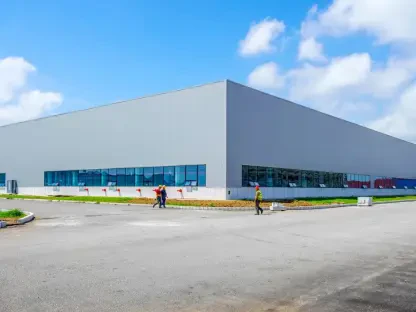Key Performance Indicators (KPIs) play an indispensable role in effective warehouse management by providing business leaders with essential tools to assess their company’s performance. These crucial metrics help set attainable goals while pinpointing areas in need of improvement. Within a warehouse context, KPIs assist managers in making more informed decisions, which ultimately leads to optimized costs, increased operational efficiency, improved workplace safety, and enhanced customer satisfaction. By carefully tracking and analyzing KPIs, warehouse managers can streamline daily operations, leading to both immediate and long-term benefits.
Essential KPIs for Warehouse Operations
Inventory Accuracy
Inventory accuracy is paramount for warehouses, as it ensures stock levels can meet customer demand without generating surplus inventory or running into inadequate supply issues, which can significantly harm customer satisfaction. Outdated methods such as Excel or manual tracking processes often result in inaccuracies, making it essential to adopt more advanced techniques. The implementation of barcoding systems integrated with Computerized Maintenance Management Systems (CMMS) can lead to better inventory control. Such modern integrations significantly reduce costs by minimizing human error and enhancing the ability to track inventory seamlessly.
Effective inventory accuracy also facilitates just-in-time inventory practices, which save on storage costs and improve cash flow by keeping only necessary stock on hand. Accurate inventory data helps avoid the risk of both overstocking and stockouts, thus maintaining a balance that meets customer needs efficiently. This KPI also assists in planning and forecast accuracy, making it easier to predict future inventory requirements based on actual data rather than estimates, leading to more strategic decision-making.
Efficiency of Receiving
Receiving stock is one of the most critical warehouse operations, which therefore makes its efficiency a vital KPI to monitor. This KPI encompasses various aspects, such as the volume of goods received, the number of customer returns, instances of missing and broken stock, and return-to-vendor stock. Organizing this data by source and time is crucial, as it helps pinpoint potential issues with specific suppliers, the timing of deliveries, and the rate at which returns occur. Efficiency in receiving stock directly impacts the overall flow of warehouse operations.
By emphasizing precise counting rates and identifying deficiencies early in the receiving process, warehouse managers can prevent downstream inefficiencies that could disrupt the entire operation. Automating parts of the receiving process with the help of advanced logistics software can further enhance accuracy and speed, thus leaving less room for human error. Efficiency in receiving also involves proper documentation and swift data entry, ensuring that each received item is accurately accounted for and timely entered into the inventory system.
Cost Management KPIs
Picking and Packing Costs
Order picking is perhaps one of the most expensive and labor-intensive processes in warehouse operations, which makes monitoring its associated costs essential. KPIs in this area should evaluate the cost per line item picked, the number of orders picked per hour, picking labor costs, consumables usage, and cycle times per order. By keeping a close eye on these metrics, warehouse managers can identify inefficiencies and areas needing improvement. Improving picking and packing accuracy is critical, as reductions in errors lead to higher order accuracy and, consequently, greater customer satisfaction.
Streamlining these processes with advanced technology can help reduce labor costs and minimize errors. For example, implementing automated picking systems with assistive robotics or pick-to-light technology can drastically improve picking speed and accuracy. Similarly, optimizing the layout and design of the warehouse can cut down on travel time, making the entire process faster and more cost-effective. Accurate tracking of consumables used in packing also ensures that resources are managed efficiently, preventing wastage and reducing overall operational costs.
Inventory Turnover
High inventory turnover rates serve as an indicator of an efficient warehouse. Monitoring this KPI helps assess buying practices and product demand, ensuring that inventory keeps moving. The inventory turnover rate, calculated as the number of times a warehouse cycles through its entire inventory annually, offers essential insights into how well the products are selling. This metric should be compared against industry standards to contextualize performance and make necessary adjustments to procurement strategies.
A high turnover rate suggests robust sales and effective inventory management, while a low turnover rate could indicate overstocking or sluggish sales, requiring immediate action to avoid potential losses. Effective inventory turnover also helps in reducing storage costs and minimizes the risk of obsolescent stock. Integrating robust forecasting tools can aid in improving inventory turnover by anticipating demand more accurately and ensuring that stock levels are aligned with actual sales patterns. This balance ultimately leads to better cash flow and more agile warehouse operations.
Customer Satisfaction KPIs
Customer Cycle Order Time
Customer-facing metrics, such as the customer cycle order time, are vital as they directly reflect overall satisfaction with warehouse performance. Customers generally expect prompt order fulfillment, and this KPI helps warehouse managers track and optimize delivery windows to align with industry expectations. Fast and reliable order fulfillment is a crucial component in meeting and exceeding customer satisfaction, and efficient management of this KPI can significantly enhance a warehouse’s reputation.
Additionally, ensuring an efficient and hassle-free return process that matches the ease of ordering plays a significant role in overall customer satisfaction. Customers appreciate a smooth and quick return process, which can positively influence their perception of the service and encourage repeat business. Warehouse managers should focus on reducing the cycle time without compromising accuracy by employing strategies such as optimizing routing, leveraging real-time data analytics, and utilizing automated sorting systems.
Order Accuracy
Order accuracy is another critical KPI that ensures the right items are shipped correctly, thereby maintaining customer satisfaction and reducing costly returns. This KPI measures the frequency of customer returns due to incorrect items, with the ultimate goal of achieving perfect order accuracy. High levels of order accuracy minimize both the trust and financial impacts caused by shipping errors. Meeting this KPI consistently can differentiate a warehouse from its competitors by establishing it as a reliable and efficient partner.
Implementing rigorous quality control processes and leveraging technology such as warehouse management systems (WMS) can play a substantial role in maintaining high order accuracy. Automated validation steps during the picking, packing, and shipping stages help reduce human error and increase precision. Employing technologies like barcode scanning or RFID tagging further enhances accuracy by ensuring that each item is tracked and verified throughout the process. These steps lead to greater customer trust and loyalty, which are invaluable assets for any business.
Operational Efficiency KPIs
Dock-to-Stock Cycle Time
The dock-to-stock cycle time measures the duration it takes to move a shipment from its arrival at the dock to when it’s ready for storage. This KPI reflects the efficiency of this essential transition and is crucial for maintaining smooth warehouse operations. Warehouses often face delays during this phase due to manual processes for receiving and inventory input. Investing in the right tools, such as AI-driven systems and automation technologies, is critical for improving this KPI.
Streamlining the dock-to-stock process involves minimizing manual handling and data entry tasks that can slow down operations. Implementing automated receiving and sorting systems can accelerate the transition from dock to stock. Reducing cycle times can have cascading benefits, including faster inventory turnover, improved order fulfillment rates, and better overall warehouse efficiency. Regularly analyzing dock-to-stock cycle time data helps identify bottlenecks and enables managers to make data-driven decisions to enhance operational performance.
Perfect Order Rate (POR)
The Perfect Order Rate (POR) encompasses several KPI elements, providing a comprehensive metric for assessing the performance of order fulfillment. This KPI evaluates the accuracy, timeliness, and completeness of orders, offering a holistic view of how well a warehouse meets customer expectations. Maintaining a high POR is fundamental for customer satisfaction and operational efficiency, as it directly correlates with the quality and reliability of service provided.
Achieving a high POR involves ensuring that each order is delivered accurately, on time, and without any missing components. This requires coordinated efforts across various stages of the warehouse operation, from receiving and inventory management to picking, packing, and shipping. Leveraging advanced WMS and order management systems (OMS) can enhance the capabilities to meet these stringent requirements. Regularly monitoring POR helps identify areas needing improvement and drive continuous performance enhancements, ultimately leading to a more efficient and customer-centric warehouse operation.
Feedback and Improvement KPIs
To effectively enhance our processes, feedback and improvement Key Performance Indicators (KPIs) are essential. KPIs are designed to measure progress in various areas and help us identify opportunities for refinement. Regular assessment and analysis of these KPIs enable us to implement targeted actions that drive continuous improvement. By focusing on specific metrics such as customer satisfaction, response times, and quality of service, we can ensure that our efforts are aligned with our overall strategic objectives.
Returned Inventory Feedback
Understanding the reasons behind customer returns, whether due to wrong items, defective products, or other issues, is invaluable for continuous improvement. This feedback is crucial as it helps identify and rectify common problems, leading to better products and processes. Analyzing return data provides insights into where improvements can be made in quality control, inventory management, and shipping processes.
Regularly collecting and reviewing returned inventory feedback allows warehouse managers to address root causes effectively. Implementing solutions based on this feedback can lead to significant improvements in operational efficiency and customer satisfaction. Using detailed return analysis, for example, a high rate of returns for defective items might indicate the need for better quality control practices or more stringent supplier standards. Ensuring that all relevant teams are informed about return reasons and taking corrective actions creates a culture of continual improvement that benefits the entire warehouse operation.
Best Practices for Measuring Warehouse KPIs
Define Goals
Establishing clear and quantifiable goals ensures focus on relevant KPIs that support warehouse objectives. This step is crucial for aligning the entire team towards common targets and achieving desired outcomes. Defined goals provide a benchmark against which performance can be measured, offering a clear path for improvement.
Goal-setting should involve input from various stakeholders, including warehouse staff, management, and customers, to ensure that the defined objectives are comprehensive and achievable. Goals must be specific, measurable, attainable, relevant, and time-bound (SMART) to serve as effective guides for performance measurement. Regularly reviewing and adjusting these goals in response to changing circumstances and new insights helps maintain their relevance and ensures that the warehouse continues to strive toward optimal performance.
Identify Relevant KPIs
Choosing KPIs aligned with specific goals, such as improving receiving operations, tracking costs, and assessing accuracy, is essential for effective warehouse management. This ensures that the metrics being tracked are directly contributing to the overall efficiency and effectiveness of the warehouse operations. Identifying the most relevant KPIs requires a thorough understanding of the warehouse’s unique challenges and objectives.
It’s important to select KPIs that offer actionable insights, meaning that the data collected can be used to implement tangible improvements. For example, tracking inventory accuracy KPIs can lead to the adoption of better inventory management systems. Similarly, monitoring picking and packing costs can highlight inefficiencies that can be addressed through process optimization or technological upgrades. Regularly reviewing and updating the chosen KPIs ensures they remain aligned with the warehouse’s evolving needs and goals.
Incremental Steps
By adopting small, incremental steps towards larger goals, organizations can maintain flexibility and adapt to changing circumstances more easily. This approach minimizes risk and allows for continuous improvement based on feedback and results.
Introduce changes gradually to avoid overwhelming staff and ensure a smooth transition to new practices. This incremental approach helps manage resistance to change and allows for better adaptation to new processes. When changes are introduced in smaller, manageable steps, it becomes easier for the team to adjust and embrace new methods without compromising current operational efficiency.
Start by implementing minor improvements and progressively build on these changes as the team becomes more comfortable and confident with the new practices. This phased approach also allows for continuous feedback, enabling managers to make necessary adjustments before rolling out broader changes. Monitoring the impact of these incremental changes through regular KPI reviews ensures that the desired improvements are being achieved and helps in identifying any additional areas that may require attention.
Engage with Operations
Leaders must understand warehouse processes intimately by experiencing them firsthand. This hands-on approach helps in identifying practical challenges and opportunities for improvement that may not be evident from a distance. Engaging directly with warehouse operations provides valuable insights that can inform more effective strategies for achieving KPIs.
By spending time on the warehouse floor, leaders can better appreciate the daily realities faced by staff and understand the intricacies of each process. This engagement fosters better communication and collaboration between management and operational staff, ensuring that improvement initiatives are grounded in real-world experience. Additionally, leaders who are actively involved in operations are better positioned to inspire and motivate their teams, driving a collective effort toward achieving the set goals.
Governance
Implementing structures to ensure consistent planning and execution across teams is crucial for keeping operations manageable and within resource capabilities. Effective governance ensures that all team members are aligned and working towards common goals, creating a cohesive and efficient environment. Governance structures provide a clear framework for decision-making, accountability, and performance measurement, which are essential for maintaining order and focus within the warehouse.
Establishing regular check-ins, performance reviews, and feedback loops helps maintain transparency and ensures that everyone remains on the same page. By defining roles and responsibilities clearly, governance structures help prevent overlap and confusion, allowing each team member to focus on their specific tasks. Ensuring that these structures are flexible enough to adapt to changing circumstances helps maintain their relevance and effectiveness over time.
Leverage Technology
Employing AI and other advanced tools to streamline inventory management and other crucial tasks is essential for modern warehouse operations. Technology can significantly enhance accuracy, efficiency, and overall performance by automating routine tasks and providing real-time data insights. Leveraging the right technological solutions can transform warehouse processes and lead to substantial improvements in KPI performance.
Advanced technologies such as warehouse management systems (WMS), automated guided vehicles (AGVs), and robotic picking systems can optimize inventory handling and order fulfillment. AI-driven predictive analytics can help in forecasting demand, ensuring that stock levels are maintained efficiently. By integrating these technologies into daily operations, warehouses can reduce errors, speed up processes, and improve overall productivity.
Third-party Logistics Providers
Utilizing third-party logistics providers’ expertise and advanced systems can enhance KPI management and operational efficiency. These providers offer specialized knowledge and resources that may not be available in-house, helping warehouses achieve higher levels of performance. Partnering with third-party logistics providers allows warehouses to leverage their advanced technologies, industry experience, and best practices.
Outsourcing certain aspects of warehouse operations, such as transportation, distribution, or order fulfillment, can free up internal resources to focus on core activities. This partnership can lead to faster deliveries, improved customer service, and lower operational costs. Regularly reviewing the performance of third-party providers against set KPIs ensures that the partnership remains beneficial and aligned with the warehouse’s strategic goals.
Transparency and Education
Informing staff about relevant KPIs and their significance is essential for fostering a culture of continuous improvement. Ongoing updates and clear communication ensure that everyone understands the importance of these metrics and how their individual performance contributes to overall warehouse efficiency. Transparency in KPI tracking helps build trust and encourages employees to take ownership of their roles in achieving set goals.
Providing regular training and educational opportunities ensures that staff are equipped with the necessary skills and knowledge to meet KPI targets. Creating an environment where employees feel valued and informed fosters a sense of accountability and motivation. Encouraging open communication and feedback helps identify potential issues early, allowing for prompt resolution and continuous performance enhancement.
Conclusion
Key Performance Indicators (KPIs) play a crucial role in effective warehouse management by equipping business leaders with essential tools to evaluate their company’s performance. These critical metrics are invaluable in setting achievable objectives and identifying areas requiring improvement. In the context of a warehouse, KPIs enable managers to make well-informed decisions that lead to optimized costs, improved operational efficiency, enhanced workplace safety, and greater customer satisfaction. By meticulously tracking and analyzing KPIs, warehouse managers can streamline daily operations, resulting in both immediate and long-term benefits.
Furthermore, KPIs provide a quantifiable measure of success, helping managers to maintain accountability and transparency within their teams. For example, tracking metrics such as order accuracy, inventory turnover, and picking efficiency can reveal specific operational bottlenecks that need addressing. By focusing on these key areas, managers can implement targeted strategies to enhance productivity and reduce waste.
In addition, consistent KPI monitoring fosters a culture of continuous improvement. Employees become more aware of their performance metrics and are motivated to align their efforts with the company’s goals. This focus on performance not only boosts individual productivity but also contributes to overall organizational success. Ultimately, the effective use of KPIs in warehouse management drives operational excellence, ensuring businesses stay competitive in an ever-evolving market.









